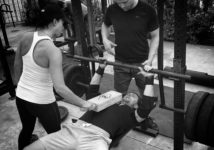
There isn’t a training goal or discipline that doesn’t benefit from variance. Said differently, a lack of variance in training stimulus is detrimental for performance across all disciplines from marathon running to throwing fastballs. When the movement selection in training is narrow, athletes experience more stagnation, more injury, and less overall expression of potential.
Luckily, varied training practices that specifically target general physical preparedness, like CrossFit, build a bigger base with variance for safer athletes that can experience limitless fitness gains. While variance can come from a long list of variables including, but not limited to, load, volume, energy systems, movement selection, time domain, and even the implements used.
Take, for instance, the tiny sliver of variance that can be found within just the use of the barbell alone. Sure, the straight bar is a staple in any strength and conditioning program, but there are opportunities to find variance with even this implement. Here are seven bars that can add endless variance to your training:
- Cambered Bar. This bar creates unique challenges in the squat and the bench press. Squatting with the cambered bar develops and challenges the upper back as the weight wants to swing forward throughout the rep. Adding the need to stabilize on the bench makes the cambered bar bench a stability builder and creates an expert lockout.
- Bow Bar. Sometimes called the “buffalo bar,” this bar provide a slight camber and the entire bar is bowed in shape. For the big, immobile guys, this bar can free up shoulders in the back squat. Benching with this bar can mix things up, too.
- Axle Bar. If you didn’t know that you loved the idea that bars rotate, you’ll learn that lesson immediately with the axle. Not only does the bar not rotate, it’s thicker grip is another challenge for all lifts.
- Safety Squat Bar. This bar is great for back squats, good mornings, and front squats believe it or not. The cushioning around the collar makes the load sit higher up to challenge the lifter’s posture, and, for athletes with arm injuries, this bar can allow them to squat heavy while holding the handles out front.
- Swiss Bar. This bar is sometimes called a “football bar,” and provides a neutral grip. Variance aside, athletes that have shoulder impingements or pain pressing the straight bar often feel better with this option.
- Bamboo Bar. While you can add kettlebells and other hanging weights with bands to any kind of bar, the bamboo bar will exaggerate the stability challenges presented by the hanging weights. Both static holds and presses are incredible for building stabilizer muscles, a better bar path, and a more robust pressing athlete.
- The Log. Borrowed from a staple strongman event, the log is rarely an actual segment of a downed tree anymore, but the premise is the same. The log a typically ten to twelve inches in diameter (like a tree trunk) and has neutral grip handles, much like the swiss bar, The log presents unique pressing challenges, obstacles in getting the bar to the shoulder, and even a greater displacements of the load out over the body’s base of support.
While there are endless equipment options, this list should open the possibilities to add variance to your training. For those of you training at DEUCE Gym, you are fortunate enough to have access to all of the above equipment.
Logan Gelbrich
@functionalcoach
3/24/17 WOD
[CrossFit Games Open Workout 17.5]
Complete 10 rounds for time of:
9 Thrusters (95/65)
35 Double Unders




